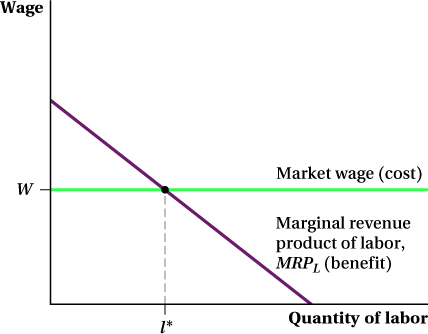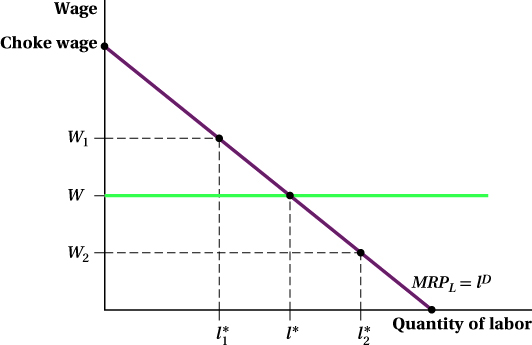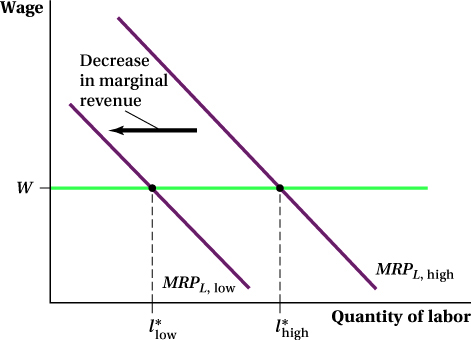13.1 Demand in a Perfectly Competitive Factor Market
We start our analysis of factor markets by looking at the market for labor inputs. The labor market is probably the most important factor market. In most economies, about 60–
The Firm’s Demand for Labor
The demand side of the labor market comprises all firms that would like to hire workers to make outputs. We begin by looking at a single firm’s demand for labor. After that, we add up such demands across all firms to obtain the total market demand for labor.
512
Let’s think about a company (say, Samsung) that needs to buy (or hire) labor to produce an output (smartphones). As with our analysis of other markets, we make some simplifying assumptions so that we can boil down complex market interactions to something we can get a grip on, while not simplifying so much that we are unable to explain what’s happening.
To make our analysis simpler, we assume all labor units are the same: An employee-
Another simplifying assumption we make is that Samsung chooses the short-
marginal revenue product of labor (MRPL)
The marginal product of labor times the marginal revenue.
To start to figure out Samsung’s demand for labor, think about the tradeoffs Samsung faces when it hires more labor. Adding more workers (or having its existing workers work more hours) allows Samsung to make more smartphones. The amount of additional production from a 1-
Samsung’s cost of hiring that additional unit of labor is the market-
Consider how this benefit (the MRPL) and cost (W) change with the amount of labor Samsung hires. We know the cost W is fixed and thus unaffected by the amount of labor hired. On the other hand, as we learned in Chapter 6, a firm’s production exhibits diminishing marginal returns to labor and capital. Thus, labor’s marginal revenue product falls as Samsung hires more workers. The marginal product of labor MPL goes down as a firm hires more labor because of diminishing returns (remember, capital inputs are fixed in the short run, so more and more people are using the same amount of capital). If the output market is perfectly competitive, we know from Chapter 8 that MR is constant and equal to the market price of the product. In this case, since MR is constant but MPL falls as more labor is hired, MRPL must drop. If instead the firm has some market power (as Samsung does in smartphones), we know from Chapter 9 that marginal revenue falls as output rises. Because more labor must be hired to produce more output, MR will fall. This drop in MR reinforces the negative effect on MPL of hiring more labor, further causing MRPL to fall when more labor is hired.
The Firm’s Labor Demand: A Graphical Approach
The changes in labor’s marginal revenue product as hiring changes are shown in Figure 13.1. Samsung’s marginal revenue product curve MRPL (measured in dollars) falls as it hires more labor, and the wage it pays to the extra workers stays constant.
We now have all the elements we need to describe Samsung’s demand for labor. Think about Samsung’s tradeoff between its benefit (MRPL) and cost (W) of hiring more labor. At relatively low levels of hiring, labor’s marginal revenue product is high because MPL is still large. As a result, MRPL > W. Samsung wants to hire any unit of labor for which this is true because that labor unit’s benefit is greater than its cost. In Figure 13.1, this is true for all quantities of labor less than l*.
513

Samsung will not want to hire any unit of labor for which MRPL < W, as is the case for labor levels above l*, because the benefit of those additional units of labor MRPL is less than their cost W.
In fact, Samsung wants to hire exactly l*. Hiring less labor would mean it isn’t employing workers whose benefit exceeds their cost. Hiring more labor than l* would mean Samsung is employing labor with a benefit below its cost. The relationship between the marginal revenue product and the wage at l* is key because it reflects what must be true at the optimal level of hiring: A firm is employing the optimal amount of labor when the marginal revenue product of labor equals the wage:
MRPL = W
choke wage
The wage at which a firm will not hire any labor.
What does this optimality condition tell us about labor demand? Any demand curve shows the quantity demanded of a good as its price changes. Here, the good is labor and the price is the wage. We just saw that the MRPL curve gives the quantity demanded at each price. If the wage changes, the amount of hiring the firm wants to do changes with it. You can see this in Figure 13.2. If the market-

We’ve been using Samsung as an example, but this outcome is true for any firm. Its labor demand curve is its MRPL curve because the MRPL curve shows how much labor the firm wants to hire at any given wage.
514
figure it out 13.1
Victoria’s Tours, Inc. is a travel company that offers guided tours of nearby mountain biking trails. Its marginal revenue product of labor is given by MRPL = 1,000 – 40l, where l is the number of tour-
What is the optimal amount of labor for Victoria’s Tours to hire?
At and above what market wage would Victoria’s Tours not want to hire anyone?
What is the most labor Victoria’s Tours would ever hire given its current marginal revenue product?
Solution:
Victoria’s Tours’ optimal amount of labor is that which equates the marginal revenue product of labor and the wage:
MRPL = W
1,000 – 40l = 600
400 = 40l
l* = 10
Victoria’s Tours’ optimal quantity of labor is 10 tour-
guide- weeks. The wage at which the MRPL of Victoria’s Tours falls to zero will be the wage at or above which the firm will not want to hire any labor. That (choke) wage, which we label wchoke, is given by setting l in the MRPL equation to zero:
wchoke = 1,000 – 40(0)
wchoke = 1,000
If the wage rises to or above $1,000 per tour-
guide- week, Victoria’s Tours will not demand any labor. Given the MRPL curve, there is an amount of labor at which the marginal revenue product becomes zero. Any more hiring, even if the wage is zero, will only reduce revenue. This maximum amount of hiring, lmax, sets MRPL = 0:
1,000 – 40lmax = 0
1,000 = 40lmax
lmax = 25
The most labor Victoria’s Tours would hire with its current MRPL curve is 25 tour-
guide- weeks.
515
There is another interpretation of the optimal hiring condition that can be seen if we break MRPL into its two components, MPL and MR:
MRPL = MPL × MR = W
Rearranging this condition gives

We see that at the firm’s optimal hiring level, marginal revenue equals the wage divided by the marginal product of labor. The ratio on the right-
derived demand
A demand for one product that results from the demand for another product.
This connection between the output a firm makes and its optimal labor hiring implies that labor demand is a derived demand, a demand for one product (such as labor) that arises from the demand for another product (a firm’s output). This connection to the firm’s output is one conceptual way in which factor markets are distinct from markets for regular goods. When consumers are buying the typical kinds of goods we’ve been dealing with in this book, they’re seeking to maximize their utility. When firms buy factors, they’re doing so to make profits.
Shifts in the Firm’s Labor Demand Curve
Like any other demand curve, the labor demand curve holds everything else constant about demand except for price (in this case, the wage). Changes in any other variable that affects labor demand show up as shifts in the labor demand curve rather than movements along it.
To understand some of those other variables, think of the separate components of the labor demand (MRPL) curve: the marginal product of labor and marginal revenue. Forces that change either component will shift labor demand.
We saw in Chapter 6 that the MPL depends on both the production function and the amount of capital the firm has. Changes in the production function from changes in total factor productivity (also known as technical change) will shift MPL and, therefore, the labor demand curve. Increases in productivity increase MPL and increase the quantity of labor demanded at each wage, thus shifting labor demand out. (Decreases in productivity have the opposite effects and shift labor demand in.)
Shifts in capital can also shift the MPL curve, but remember for now that we are looking at labor demand in the short run when capital is fixed. We will see how changes in a firm’s capital affect the firm’s long-
The relationship between shifts in marginal revenue and shifts in labor demand results from the fact that labor demand is a derived demand. If the demand for Samsung’s smartphones falls (as a result of changing tastes, improvements in the availability of substitutes, etc.), the price of Samsung’s smartphones will fall, and their marginal revenue will fall along with it. As shown in Figure 13.3, this decrease in marginal revenue shifts Samsung’s MRPL curve in from MRPL,high to MRPL,low (where “high” and “low” denote the level of smartphone demand). Because Samsung is a wage taker, it faces a fixed market wage of W per hour. Therefore, Samsung’s quantity of labor demanded falls from l*high to l*low. This outcome is intuitive: If fewer people want Samsung smartphones or have lower willingness to pay for them, Samsung won’t want to hire as many workers. In general, any variable that shifts the firm’s marginal revenue curve shifts the labor demand curve.
516

Market Labor Demand Curve
We now know how labor demand is determined at the firm level. To analyze how the labor market as a whole works, we have to add up the labor demand of all firms in the economy.
In Chapter 5, we learned that a product’s market demand curve is the horizontal sum of individual consumers’ demand curves for that product. Similarly, the market demand for labor is the horizontal sum of all firms’ labor demand curves. To compute it, we pick a wage level and add up all firms’ quantity of labor demanded at that wage to get market quantity demanded at that wage. Then we repeat the process for every possible wage. The market labor demand curve must slope down because every individual firm’s labor demand curve slopes down.
The only aspect of market labor demand that can be a bit tricky has to do with the relationship between the market wage and the price of the output that firms are hiring the labor to make. When we looked at how the firm-
Figure 13.4 illustrates how this works. At the initial market wage and output price, an industry firm has a labor demand curve of MRPL1. Given a market wage W1, it hires l*1 units of labor, as shown in panel a. If the market wage falls from W1 to W2, all industry firms’ costs fall and so does the output price. This reduction in marginal revenue shifts the firm’s labor demand curve to MRPL2. Now that the market wage is W2, the firm hires l*2 labor units. Had there been no change in output price associated with the wage drop, the firm would have hired l*NC (on MRPL1) instead. At the market level, this feedback between the market wage and the output price implies that a wage drop from W1 to W2 increases the quantity of labor demanded from L1 to L2 instead of from L1 to LNC, as would be the case without the feedback loop. Therefore, the feedback between the market wage and output price makes the market labor demand curve steeper—
517
